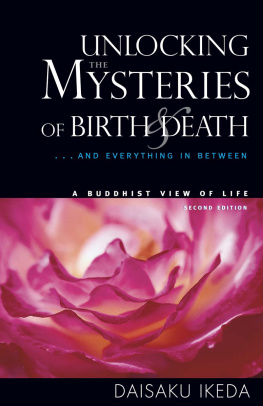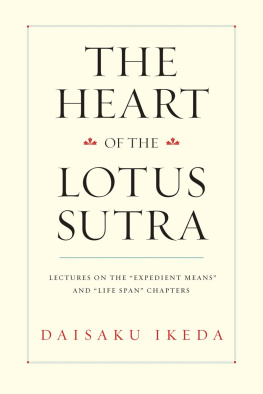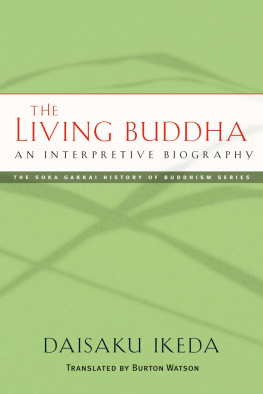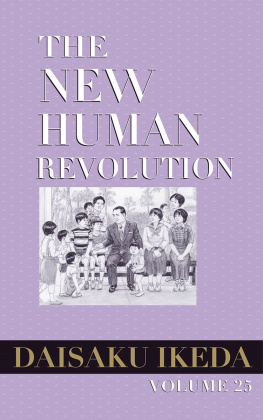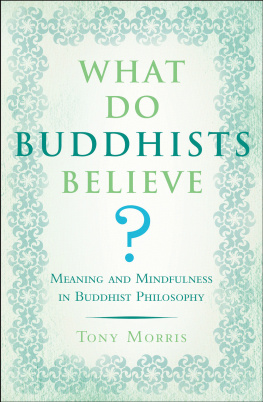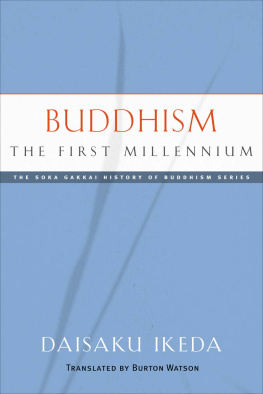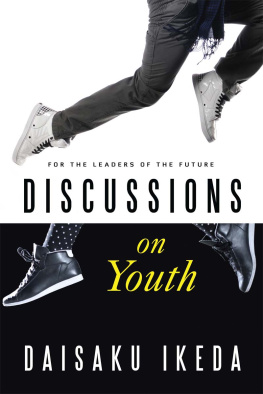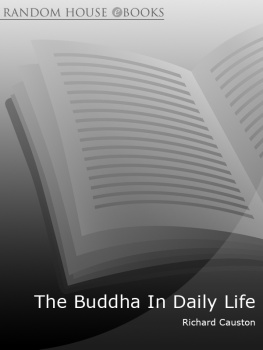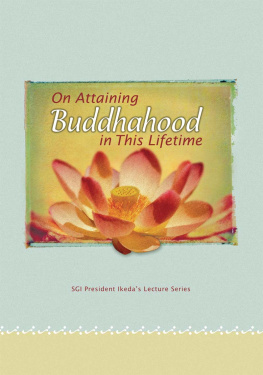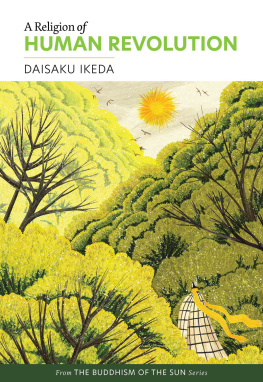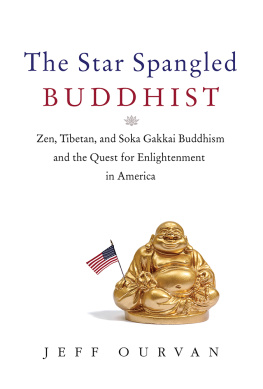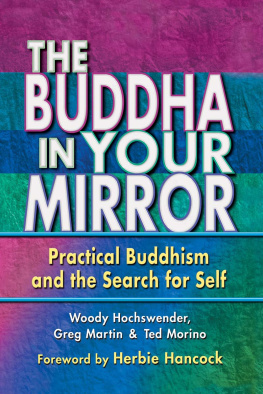
Published by Middleway Press
A division of the SGI-USA
606 Wilshire Blvd.
Santa Monica, CA 90401
1988 by Daisaku Ikeda
2003 by the Soka Gakkai
First English edition published in Great Britain in 1988 by Macdonald & Co. (Publishers) Ltd.
London & Sydney
ISBN 978-0-9723267-0-4
Design by Gopa & Ted2, Inc.
All rights reserved
Printed in the United States of America
10 9 8
Library of Congress Cataloging-in-Publication Data
Ikeda, Daisaku.
Unlocking the mysteries of birth and death / Daisaku Ikeda.
p. cm.
ISBN 0-9723267-0-7 (Paperback : alk. paper)
1. Soka GakkaiDoctrines. I. Title.
BQ8449.I384U65 2003
294.3420428--dc22
2003021963


Contents


Preface
A S THE AUTHOR, I am extremely happy that Middle way Press is publishing this revised edition of Unlocking the Mysteries of Birth and Death. Death, which is a major theme of the book, is the inevitable reality of life, and the two phases of life and death constitute an inescapable law for all beings. Confronting death at a fundamental level is an inevitable spiritual undertaking that helps us to live more profoundly and more meaningfully.
As the Latin phrase memento moriremember that you must diesuggests, we grasp the true meaning of life only when we honestly face the reality of death. Two and a half millennia ago, the desire to overcome the basic human sufferings of birth, aging, illness and death motivated the historical Buddha, Shakyamuni, to abandon his princely rank and undertake the search for truth. Buddhism originated with his enlightenment, which revealed the ultimate law of life as the foundation of the universe and the inner human cosmos. The Buddhist teachings developed and were expounded in many scriptures, from early Buddhism through Mahayana Buddhism, but the essence of them all is the Lotus Sutra, which explains the potential Buddhahoodthe Buddha natureinherent in everyone.
Over the course of the ages, Buddhism traveled southward from India to Sri Lanka, Burma, Thailand and Cambodia. In its northward movement, it passed through Central Asia, China and the Korean Peninsula to reach Japan, where Nichiren was born in the thirteenth century. Nichiren taught the ultimate expression of Shakyamunis enlightenment in the form of the universal Law, Nam-myoho-renge-kyo. In addition, he developed the distinctive Nichiren Buddhism, which subsumes the teachings and philosophies of such teachers as the Indians Nagarjuna (second or third century) and Vasubandhu (fourth or fifth century) and the Chinese Tien-tai (Tiantai; 538597). Nichiren Buddhism puts the teachings of the Lotus Sutra into actual practice for the sake of ordinary people. Indeed, Nichiren referred to himself as a practitioner of the Lotus Sutra.
Astonishing developments in science and technology make the world we live in today entirely different from the one Nichiren knew. To bridge the gap, this book attempts to set up a dialogue between our times and the foundation of Nichiren Buddhism. Its contents represent a partial explanation of the contributions that Nichirens teachings can make to the future of humanity by providing a clear perspective on todays world and helping us know how to interpret contemporary philosophy, science and the universe itself.
Though seven centuries old, the Buddhism of Nichiren provides a marvelous prescription for the helplessness and despair now pervading society. Fate, of course, does not always turn out according to our wishes, but Buddhismespecially Nichiren Buddhismpossesses the power with which we can transform destiny. It sheds light on all aspects of human life and penetrates to its core. Universally applicable to all humanity, in every circumstance, it is well worth lifelong study and application.
Conditions for individuals, society and the world at large have changed dramatically during the fifteen years that have passed since the first English-language edition of this book. As many thinkers point out, in the past, little development took place in the way humanity regarded life and death. Astonishing advances in science, however, have stimulated the desire for new views on life and death.
Newly discovered scientific facts, as well as new perspectives on life and death, are taken into consideration in this revised edition, which includes various additions, corrections and improvements in the translation. Nichirens teachings emphasize the dignity of human lifethe Buddha nature or fundamental universal lifeinherent in humanity. I have taken great care to transmit an accurate understanding of this philosophy in contemporary terms.
Since my youth I have loved the nineteenth-century American poet Walt Whitman, whose work contains praise for life itself and interpretations of the cosmos and nature that correspond with Buddhist views. For instance, his Song of the Universal includes the following passage:
Come said the Muse,
Sing me a song no poet yet has chanted,
Sing me the universal.
In the broad earth of ours,
Amid the measureless grossness and the slag,
Enclosed and safe within its central heart,
Nestles the seed perfection.
I am certain that readers of this book will discover in Buddhist philosophy a new approach to what Whitman calls the universal. Nothing could make me happier than for this book to provide an opportunity to learn, to discover and to undertake major self-revolution.
Finally, let me express my deepest gratitude to Middleway Press, the staff of the Soka Gakkai Study Department, and the many other people whose tireless efforts made this revised edition possible.
D AISAKU I KEDA
November 18, 2003


Introduction
W E ALL DESIRE HAPPINESS, and yet happiness always seems to be just beyond our reach.
Numerous philosophers have tackled the question of happiness. Without exception, I believe their conclusions have been incomplete. However many how to be happy books might appear, human beings are still largely beset by the same problems as their ancestors. The poor seek wealth, the sick yearn to be healthy, those suffering from domestic strife crave harmony, and so on. Even if we secure wealth, health and a happy home life, we inevitably find ourselves confronted by problems in other areas. Furthermore, should we somehow fashion circumstances that apparently satisfy all the conditions necessary for happiness, how long can we maintain those circumstances? Obviously not forever. Few of us can avoid the illnesses and slow weakening of the body that accompany aging, and none of us can escape death.
Next page
